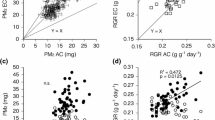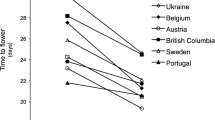Abstract
Atmospheric CO2 partial pressure (pCO2) was as low as 18 Pa during the Pleistocene and is projected to increase from 36 to 70 Pa CO2 before the end of the 21st century. High pCO2 often increases the growth and reproduction of C3 annuals, whereas low pCO2 decreases growth and may reduce or prevent reproduction. Previous predictions regarding the effects of high and low pCO2 on C3 plants have rarely considered the effects of evolution. Knowledge of the potential for evolution of C3 plants in response to CO2 is important for predicting the degree to which plants may sequester atmospheric CO2 in the future, and for understanding how plants may have functioned in response to low pCO2 during the Pleistocene. Therefore, three studies using Arabidopsis thaliana as a model system for C3 annuals were conducted: (1) a selection experiment to measure responses to selection for high seed number (a major component of fitness) at Pleistocene (20 Pa) and future (70 Pa) pCO2 and to determine changes in development rate and biomass production during selection, (2) a growth experiment to determine if the effects of selection on final biomass were evident prior to reproduction, and (3) a reciprocal transplant experiment to test if pCO2 was a selective agent on Arabidopsis. Arabidopsis showed significant positive responses to selection for high seed number at both 20 and 70 Pa CO2 during the selection process. Furthermore, plants selected at 20 Pa CO2 performed better than plants selected at 70 Pa CO2 under low CO2 conditions, indicating that low CO2 acted as a selective agent on these annuals. However, plants selected at 70 Pa CO2 did not have significantly higher seed production than plants selected at 20 Pa CO2 when grown at high pCO2. Nevertheless, there was some evidence that high CO2 may also be a selective agent because changes in development rate and biomass production during selection occurred in opposite directions at low and high pCO2. Plants selected at high pCO2 showed no change or reductions in biomass relative to control plants due to a decrease in the length of the life cycle, as indicated by earlier initiation of flowering and senescence. In contrast, selection at low CO2 resulted in an average 35% increase in biomass production, due to an increase in the length of the life cycle that resulted in a longer period for biomass accumulation before senescence. From the Arabidopsis model system we conclude that some C3 annuals may have produced greater biomass in response to low pCO2 during the Pleistocene relative to what has been predicted from studies exposing a single generation of C3 plants to low pCO2. Furthermore, C3 annuals may exhibit evolutionary responses to high pCO2 in the future that may result in developmental changes, but these are unlikely to increase biomass production. This series of studies shows that CO2 may potentially act as a selective agent on C3 annuals, producing changes in development rate and carbon accumulation that could not have been predicted from single-generation studies.
Similar content being viewed by others
Author information
Authors and Affiliations
Additional information
Received: 21 July 1999 / Accepted: 1 December 1999
Rights and permissions
About this article
Cite this article
Ward, J., Antonovics, J., Thomas, R. et al. Is atmospheric CO2 a selective agent on model C3 annuals?. Oecologia 123, 330–341 (2000). https://doi.org/10.1007/s004420051019
Issue Date:
DOI: https://doi.org/10.1007/s004420051019




